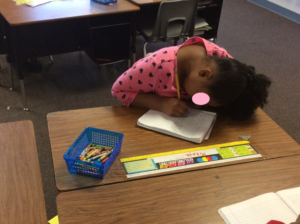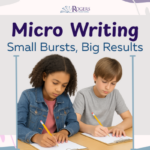** Contact us if you would like Rogers Education Consulting to bring an engaging, hands-on Writers’ Workshop session to your campus **
 In a true Writers’ Workshop, students are busy working on drafts of multiple works at the same time. While I believe that there are some aspects of frameworks like Writers’ Workshop that are left up to your professional judgment, writing multiple drafts is one aspect that shouldn’t be “messed with.” I understand the fear of losing control of what students are writing or what could look like chaos to outsiders. I get it. A little secret – it is frightening to me too! You must have a LOT of trust in your students in order to let them have the freedom to write several things at once, and it takes a LOT of organization by the teacher. Even though this is a scary scenario, it is vital to student success.
In a true Writers’ Workshop, students are busy working on drafts of multiple works at the same time. While I believe that there are some aspects of frameworks like Writers’ Workshop that are left up to your professional judgment, writing multiple drafts is one aspect that shouldn’t be “messed with.” I understand the fear of losing control of what students are writing or what could look like chaos to outsiders. I get it. A little secret – it is frightening to me too! You must have a LOT of trust in your students in order to let them have the freedom to write several things at once, and it takes a LOT of organization by the teacher. Even though this is a scary scenario, it is vital to student success.
If students are only writing one expository paper, or one poem, or one narrative, there is a good chance the teacher is guiding them through the process. Sometimes, even grabbing a hold of the student and running them through the process! In this case, the students will produce a paper, but most of the work was likely done by the teacher. For a vast majority of students, one time through is never enough, regardless of what you are learning. As a gymnastics coach, I wouldn’t have my student practice a back handspring once and then tell them to go ahead and do it in the competition! In most arenas, that is a ludicrous thought, but in school, we tend to adopt that line of thinking that says, practice once and then perform. The truth is that most of the work in writing is done in the draft stage. It is not enough for me to have students practice editing for sentences in one paper or learning to organize an expository paper one time. If they are going to retain it, they need to practice it many times.
Recently, I was modeling writing instruction in a fourth-grade class. Students were working on expository writing. In Texas, fourth grade is  THE testing year. Before we started, I had students brainstorm a list of possible topics. From there, they needed to organize their main points. In this example, students brainstormed places and objects that were special to them. From the list, they had to choose one place or object and one or two main reasons why this place was special. This is not easy! Students have to think broadly, and somewhat abstractly, and have main ideas instead of focusing on details. Practicing this thought process one time is not enough. I had students complete this step multiple times with different places and/or objects from their list. While students did this, I conferenced with the students, helping them drill down to their main ideas. All of the brainstorms will eventually become a rough draft. Over the next couple of weeks, I will teach the students how to develop their expository papers. I will teach them how to add details and explanations, how to explode the moment, how to write complete sentences, how to write an introduction, etc. With each lesson, students will work on the skill with multiple papers, making sure to really practice the skill.
THE testing year. Before we started, I had students brainstorm a list of possible topics. From there, they needed to organize their main points. In this example, students brainstormed places and objects that were special to them. From the list, they had to choose one place or object and one or two main reasons why this place was special. This is not easy! Students have to think broadly, and somewhat abstractly, and have main ideas instead of focusing on details. Practicing this thought process one time is not enough. I had students complete this step multiple times with different places and/or objects from their list. While students did this, I conferenced with the students, helping them drill down to their main ideas. All of the brainstorms will eventually become a rough draft. Over the next couple of weeks, I will teach the students how to develop their expository papers. I will teach them how to add details and explanations, how to explode the moment, how to write complete sentences, how to write an introduction, etc. With each lesson, students will work on the skill with multiple papers, making sure to really practice the skill.
How do you organize all the writing?



Thanks for taking the time to come to Haynes and teach us about editing and revising!
I’m intrigued to try this in my room. I’ve always worked on one piece of writing at a time.
Thanks for sharing these wonderful resources
I am new to teaching writing, and I have always been scared to have students working on more than one thing. I definitely see the value and understand how it can help them!
It is a bit scary. A little secret is that it’s scary for veteran teachers as well! Definitely give it a shot though, because it will help your students become stronger and more independent writers.
I really like this idea and I will definitely take it into my own classroom.
Thanks for all the helpful information!
This really opened my eyes because we typically go through the entire writing process with one piece/topic at a time, but have them brainstorm different topics and then select one to write. If we gave them that creative freedom to start multiple drafts with their different thoughts, we are more willing to have an authentic piece of writing at the end. Food for thought, thanks!
I’m so glad! I used to do the same! It was hard to switch to writing multiple drafts, but I’m glad I did.
I greatly enjoyed the training and the huge amount of resources you have provided for us. I cannot wait to incorporate the idea of multiple writing pieces at a time, especially for those students who tend to be fast finishers. These new ideas spark my interest in teaching writing and I really hope that it motivates my students!!
This makes my heart happy! I look forward to hearing how writing multiple drafts is going in your classroom.